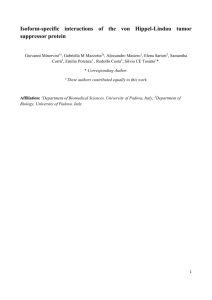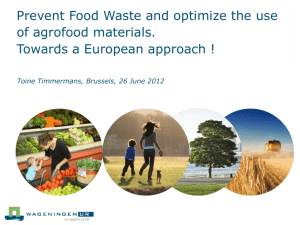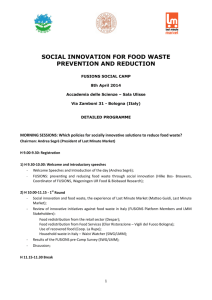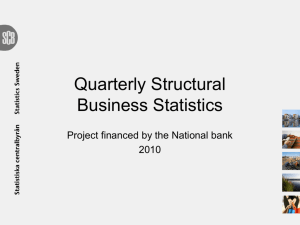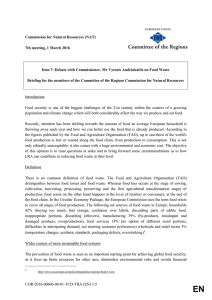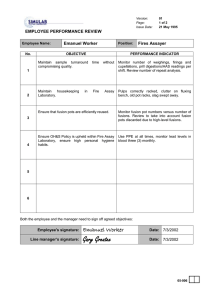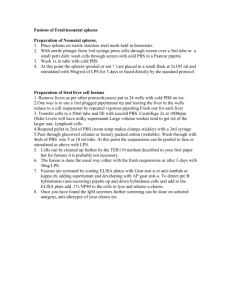FUSION D18 for Milan 151011 layout
advertisement
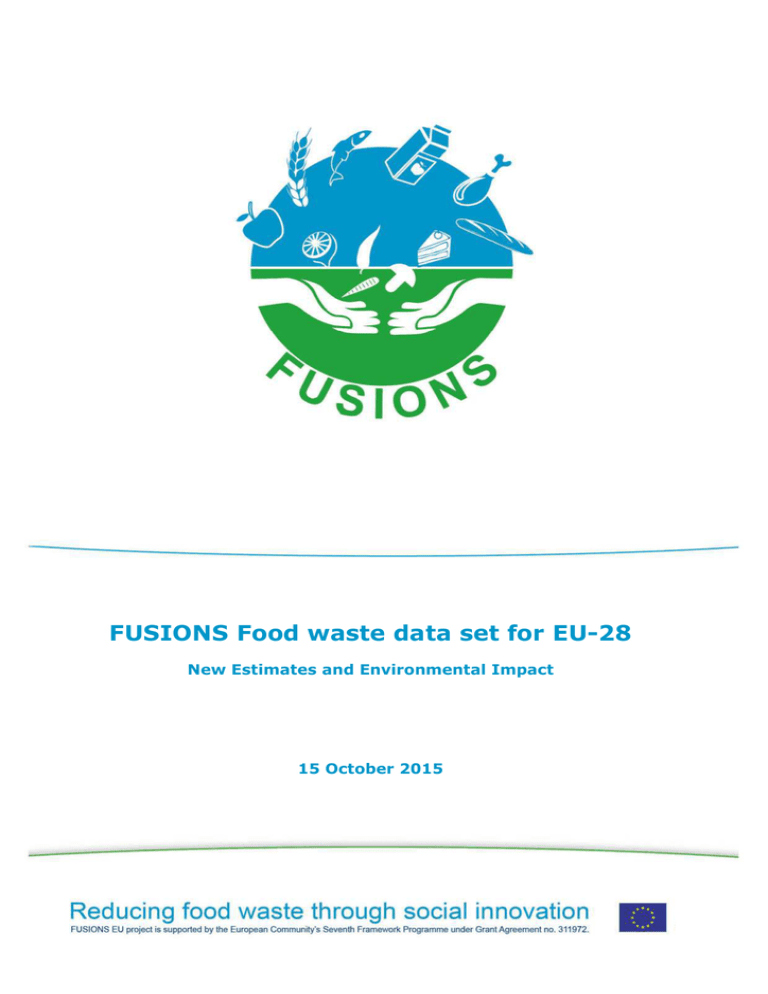
FUSIONS Food waste data set for EU-28 New Estimates and Environmental Impact 15 October 2015 Food waste is an issue of importance to global food security and good environmental governance, directly linked with all aspects of sustainability (e.g. availability of resources, increasing costs and health). The amount of food produced but not consumed leads to negative impacts throughout the food supply chain and households. There is a pressing need to prevent food waste to make the transition to a resource efficient Europe. Previous studies show the necessity for more consistent and comparable data in order to decrease the uncertainties and making it possible to better understand the magnitude of the problem, and the scale of the potential opportunities. One task performed within FUSIONS has been to calculate an EU-28 estimate for food waste. In this study data has been obtained using a combination of national waste statistics and findings from selected research studies. The data obtained has been filtered to ensure that it was aligned to the FUSIONS definitional framework and food waste definition and used a robust methodology; hence that data is comparable between countries. The FUSIONS definitional framework is shown in Figure 1. Figure 1. The FUSIONS technical framework defining the Food supply chain and Food waste Section B-ii shows the FUSIONS definition for ‘food waste’. It is defined by the final destination of all food, and inedible parts of food, removed from the food supply chain. Any food and inedible parts of food, removed from the food supply chain sent to destinations B3-B11 are termed ‘food waste’. Any food, or inedible parts of food, sent to animal feed, bio-material processing or other industrial uses (B1-B2) are termed ‘valorisation and conversion’ and are distinct from ‘food waste’. 2 | FUSIONS Reducing food waste through social innovation Where there were gaps for individual member states, estimates have been made based on data obtained from member states providing data of sufficient quality. This extrapolation was built up sector by sector. Data was only obtained for up to a quarter of member states (the exact figure depending on the sector, see table 1 below) and the process of scaling the information from these member states to the whole EU-28 is responsible for a relatively large uncertainty around the resulting estimate of EU food waste. However this data set should be seen as the best estimate for EU food waste based on the evidence currently available. The amounts will be presented in detail via a final FUSIONS report “Food waste data set for EU-28” in spring 2016. The results indicate that EU-28 produce about 100 Mtonnes of food waste every year, and that about 45% of this is generated from households. This estimate is for 2012 and includes food waste according to FUSIONS’ definitional framework. There is a moderately high uncertainty around the estimate; the approximate 95% confidence interval is ± 23 million tonnes. The Global Warming Potential (GWP) of current food waste for EU in 2011 is estimated to at least around 227 MT of CO2-Equivalents (Eq.). This is 16% of the total GWP of food utilization in EU in 2011. Further details will be found in report “Criteria for and baseline assessment of environmental and socio-economic impacts of food waste” that will be published during autumn 2015. Figure 2. Estimation of Global Warming Potential (GWP) of current consumed and wasted food in EU in 2011 in MT CO2-Equivalents A key recommendation from this exercise for accurately quantifying food waste in EU-28 is to increase the number of EU member states that measure food waste robustly. This recommendation applies to all sectors; however, the lack of data was particularly acute for the primary production sector. A more reliable estimate can be achieved by ensuring that those studies that do take place use a consistent definitional framework and definition of food waste, have robust sampling procedures in place, and use measurement methods that are accurate. FUSIONS is taking necessary actions in order to facilitate this work outlining further the practical application of the principles, developing a Quantification Manual (to be published early 2016), and encouraging member states to have structures in place for regular food waste quantification studies. FUSIONS Reducing food waste through social innovation | 3 FUSIONS Contact persons: Food waste amounts: Åsa Stenmarck – asa.stenmarck@ivl.se Sustainability calculations: Silvia Scherhaufer - silvia.scherhaufer@boku.ac.at Definitional framework: Karin Östergren – karin.ostergren@sp.se Quantification manual: Clément Tostivint - ctostivint@deloitte.fr Project coordinator: Toine Timmermans - toine.timmermans@wur.nl Related publications from FUSIONS projects can be downloaded from www.eu-fusions.org: • • • • • FUSIONS Definitional Framework for Food Waste Review of EUROSTAT's reporting method and statistics Standard approach on quantitative techniques Drivers of current food waste generation, threats of future increase and opportunities for reduction To be published by mid-November: Criteria for and baseline assessment of environmental and socio-economic impacts of food waste 4 | FUSIONS Reducing food waste through social innovation Table 1: Matrix describing to what extent data was taken into account when estimating the total food waste amounts. Country 1. Production (NACE 1-3) 2. Processing (NACE 10-11) 3. Wholesale and logistics (NACE 46) 4. Retail and markets (NACE 47) 5. Redistribution (food donation etc.) 6. Food service (NACE 56) 7. Household Data has been submitted but no estimation of food waste amounts has been made. Data of sufficient quality Data of sufficient quality No data available No data available Food waste data of low quality No data available Food waste data of low quality No data available No data available No data available Low food waste amounts. Several or major waste flows not being covered. No data available Low food waste amounts. Several or major waste flows not being covered. No data available Austria No data available Food waste data of low quality No data available Data of sufficient quality Belgium Bulgaria Food waste data of low quality No data available Food waste data of low quality No data available Food waste data of low quality No data available Food waste data of low quality No data available Low food waste amounts No data available Low food waste amounts. Several or major waste flows not being covered. No data available Low food waste amounts. Several or major waste flows not being covered. No data available Food waste data of low quality No data available Lowfood waste amounts. No explanation on what was Several or major waste flows not included. being covered. Croatia Cyprus Low food waste amounts No data available Czech republic Low food waste amounts without any explanation given Low food waste amounts Food waste data of low quality Data of sufficient quality No data available Data of insufficient quality as only edible food waste was reported. Low food waste amounts Data of sufficient quality Data of sufficient quality Very high food waste amounts Data of sufficient quality No data available No data available Data of sufficient quality Low food waste amounts No information on what was included was retrieved. Data of sufficient quality Finland No data available Data of insufficient quality as only edible food waste was reported. No data available High food waste amounts. No explanation on what was included. No data available Data of sufficient quality Data of sufficient quality France Germany Low food waste amounts. Several or major waste flows not being covered. Data of sufficient quality Data of sufficient quality Data of sufficient quality High food waste amounts. No explanation on what was included. Data of sufficient quality High food waste amounts. No explanation on what was included. No data available Data of sufficient quality No data available Data of sufficient quality Data of sufficient quality No information on what was included was retrieved. Data of sufficient quality Greece Hungary Low food waste amounts without any explanation given No data available Data of sufficient quality No data available Low food waste amounts. No information on what was No information on what was included was retrieved. included was retrieved. No data available No data available Denmark Estonia Ireland No data available High food waste amounts. No data available Data of sufficient quality No data available No data available Data has been submitted but no High food waste amounts. High food waste amounts. estimation of food No information on what was No explanation on what was waste amounts has included was retrieved. included. been made. 5 | FUSIONS Reducing food waste through social innovation No data available No data available Data of sufficient quality Data of sufficient quality 1. Production (NACE 1-3) 2. Processing (NACE 10-11) 3. Wholesale and logistics (NACE 46) 4. Retail and markets (NACE 47) 5. Redistribution (food donation etc.) 6. Food service (NACE 56) 7. Household Italy Latvia Data of sufficient quality No data available Data of insufficient quality as only edible food waste was reported. No data available Data of sufficient quality No data available Data of sufficient quality No data available No data available No data available No data available No data available No explanation given? No data available Lithuania Low food waste amounts Data of sufficient quality Data of insufficient quality. Data of insufficient quality. No data available Data of insufficient quality. No information on what was included was retrieved. No data available Low food waste amounts without any explanation given No data available Low food waste amounts without any explanation given Data of sufficient quality (excluding sewer and home composting) Country Luxembourg Malta No data available Data of insufficient quality. Data of sufficient quality No data available Data of sufficient quality No data available No data available No data available Data of sufficient quality (excluding sewer and home composting) Several or major waste flows not being covered. No data available Data of sufficient quality (excluding home composting) No data available Netherlands Poland No data available No data available No data available No data available No data available No data available Data of sufficient quality No data available Data has been submitted but no estimation of food waste amounts has been made. No data available Portugal Romania Low food waste amounts without any explanation given No data available Low food waste amounts. Several or major waste flows not being covered. No data available No data available No data available No data available No data available No data available No data available No data available No data available No data available No data available Slovakia Low food waste amounts. Several or major waste flows not being covered. Several or major waste flows not being covered. No data available No data available No data available No data available No data available Slovenia Spain Low food waste amounts. Several or major waste flows not being covered. No data available No explanation of what was included in the amounts could be given. No data available Data of sufficient quality No data available Data of sufficient quality No data available No data available No data available Low food waste amounts. Several or major waste flows not being covered. No data available Park waste and non household MSW are included in the amounts No data available Sweden Low food waste amounts. Several or major waste flows not being covered. Byproducts are included in the amounts. No data available Data of sufficient quality No data available Data of sufficient quality Data of sufficient quality United Kingdom Data of insufficient quality. Data of sufficient quality Data of sufficient quality Data of sufficient quality No data available Data of sufficient quality Data of sufficient quality 6 | FUSIONS Reducing food waste through social innovation
